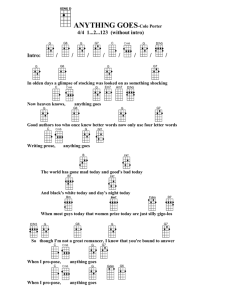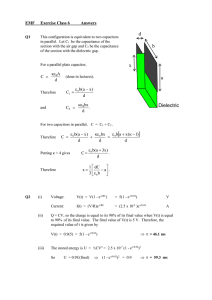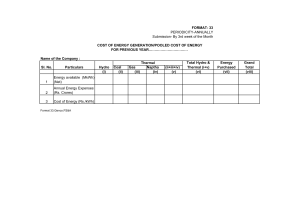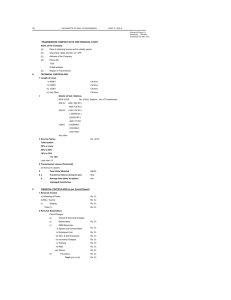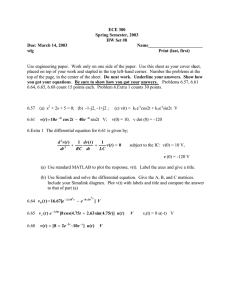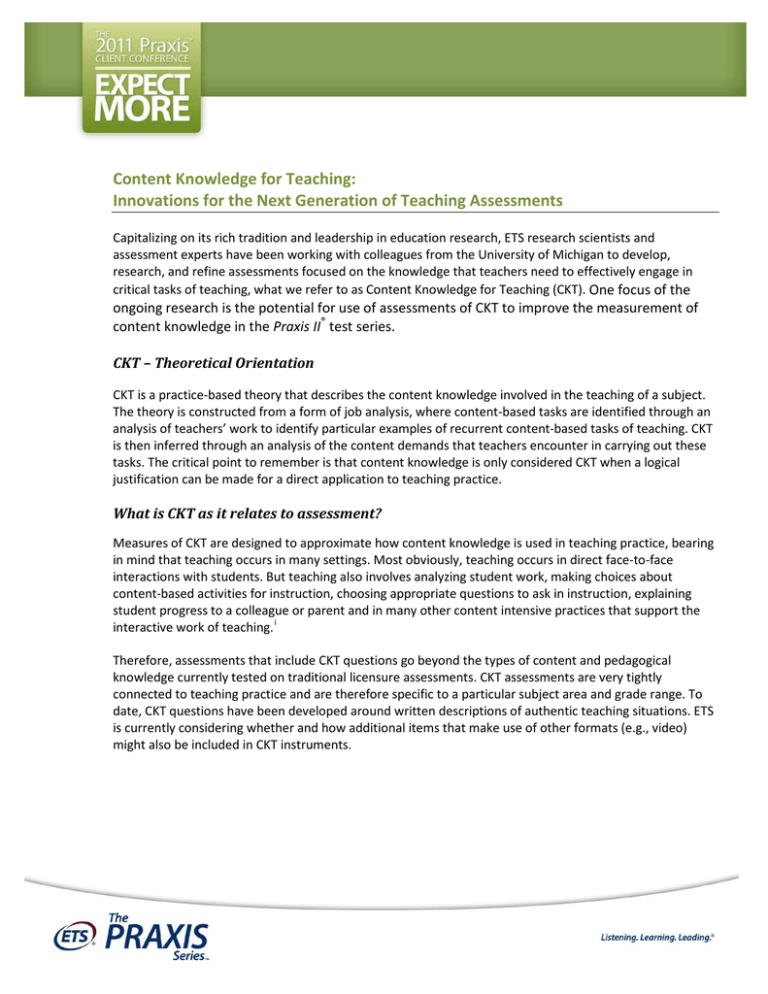
Content Knowledge for Teaching:
Innovations for the Next Generation of Teaching Assessments
Capitalizing on its rich tradition and leadership in education research, ETS research scientists and
assessment experts have been working with colleagues from the University of Michigan to develop,
research, and refine assessments focused on the knowledge that teachers need to effectively engage in
critical tasks of teaching, what we refer to as Content Knowledge for Teaching (CKT). One focus of the
ongoing research is the potential for use of assessments of CKT to improve the measurement of
content knowledge in the Praxis II® test series.
CKT – Theoretical Orientation
CKT is a practice-based theory that describes the content knowledge involved in the teaching of a subject.
The theory is constructed from a form of job analysis, where content-based tasks are identified through an
analysis of teachers’ work to identify particular examples of recurrent content-based tasks of teaching. CKT
is then inferred through an analysis of the content demands that teachers encounter in carrying out these
tasks. The critical point to remember is that content knowledge is only considered CKT when a logical
justification can be made for a direct application to teaching practice.
What is CKT as it relates to assessment?
Measures of CKT are designed to approximate how content knowledge is used in teaching practice, bearing
in mind that teaching occurs in many settings. Most obviously, teaching occurs in direct face-to-face
interactions with students. But teaching also involves analyzing student work, making choices about
content-based activities for instruction, choosing appropriate questions to ask in instruction, explaining
student progress to a colleague or parent and in many other content intensive practices that support the
interactive work of teaching. i
Therefore, assessments that include CKT questions go beyond the types of content and pedagogical
knowledge currently tested on traditional licensure assessments. CKT assessments are very tightly
connected to teaching practice and are therefore specific to a particular subject area and grade range. To
date, CKT questions have been developed around written descriptions of authentic teaching situations. ETS
is currently considering whether and how additional items that make use of other formats (e.g., video)
might also be included in CKT instruments.
Research History
For more than 25 years, researchers have been exploring the idea that “there is content knowledge unique
to teaching – a kind of subject matter specific professional knowledge.” ii Lee Shulman and his colleagues
first proposed the idea in the 1980s, using the term “pedagogical content knowledge” to refer to this new
domain of teacher knowledge.iii Through their work, Shulman and his associates sought to “represent
content understanding as a special kind of technical knowledge key to the profession of teaching.” iv One of
seven categories of teacher knowledge (see Figure 1), Shulman defined pedagogical content knowledge
(PCK) as “that special amalgam of content and pedagogy that is uniquely the province of teachers, their
own special form of professional understanding.” v
Figure 1: Shulman’s Major Categories of Teacher Knowledge
•
•
•
•
•
•
•
General pedagogical knowledge, with special reference to those broad principles and strategies of
classroom management and organization that appear to transcend subject matter
Knowledge of learners and their characteristics
Knowledge of educational contexts, ranging from workings of the group or classroom, the governance
and financing of school districts, to the character of communities and cultures
Knowledge of educational ends, purposes, and values, and their philosophical and historical grounds
Content knowledge
Curriculum knowledge, with particular grasp of the materials and programs that serve as “tools of the
trade ” for teachers
Pedagogical content knowledge, that special amalgam of content and pedagogy that is uniquely the
province of teachers, their own special form of professional understanding
(Shulman, 1987, p. 8; quoted in Ball et al, 2008, p. 391)
Implicit in Shulman and his associates’ work was “the argument that high-quality instruction requires a
sophisticated, professional knowledge [PCK] that goes beyond simple rules such as how long to wait for
students to respond.” vi Shulman wrote:
The most useful forms of representation of those ideas, the most powerful analogies, illustrations,
examples, explanations, and demonstrations—in a word, the most useful ways of representing and
formulating the subject that makes it comprehensible to others . . . Pedagogical content knowledge
also includes an understanding of what makes the learning of specific topics easy or difficult: the
conceptions and preconceptions that students of different ages and backgrounds bring with them
to the learning of those most frequently taught topics and lessons. vii
For well over a decade, Deborah Ball and her colleagues have undertaken extensive research with
mathematics teachers, studying how they carry out the work of teaching mathematics. Their work has
deepened our understanding of Shulman’s concept of PCK in the field of mathematics instruction. As Ball
and her colleagues wrote in 2008:
By “mathematical knowledge for teaching,” we mean the mathematical knowledge needed to carry
out the work of teaching mathematics. Important to note here is that our definition begins with
teaching, not teachers. It is concerned with the tasks involved in teaching and the mathematical
demands of these tasks. Because teaching involves showing students how to solve problems,
answering students’ questions, and checking students’ work, it demands an understanding of the
content of the school curriculum. Beyond these obvious tasks, we seek to identify other aspects of
the work and to analyze what these reveal about the content demands of teaching. viii
Two questions have guided their work:
1. What are the recurrent tasks and problems of teaching mathematics? What do teachers do as
they teach mathematics?
2. What mathematical knowledge, skills, and sensibilities are required to manage these tasks?
Summarizing their extensive work, Ball and her associates wrote:
Although these analyses are ongoing, we see persuasive evidence that the mathematical
knowledge needed for teaching is multidimensional. That is, general mathematical ability does not
fully account for the knowledge and skills entailed in teaching mathematics (Hill et al., 2004). Like
Shulman, we think it important to identify, isolate, and measure the knowledge and skill distinctive
of teaching and essential to establishing its status as a professional activity—even though we
recognize that in actual teaching such boundaries can seem artificial…. ix
Researchers at the University of Michigan have been undertaking similar studies in the field of reading and
have designed and tested CKT items at the elementary level. They are also finding evidence that there is
specialized knowledge for teaching reading at the elementary level across two broad topic areas:
comprehension and word analysis. x
Researchers have also begun to establish criteria for CKT items for physical science and social studies. xi And,
for the last two years, ETS and University of Michigan researchers have been developing and testing CKT
measures for mathematics teachers in later grades and also for teachers of English Language Arts as a part
of the Measures of Effective Teaching (MET) project funded by the Bill and Melinda Gates Foundation. xii
ETS is providing additional support in 2011 to expand the research and development of CKT assessments.
Defining Characteristics of CKT Assessments
CKT-based assessments have a number of distinctive characteristics.
• Because the items provide sufficient context to make both the task of teaching and its
instructional purpose clear, the test taker can see the direct link of the item to their own
practice.
• Because the items are situated in teaching, it is immediately apparent how the knowledge that
is measured matters for teaching.
• Because the items require participants to engage in thinking about and working through tasks
of teaching, they have very high levels of face validity.
• Because teaching involves ways of working with content that are often different from how
most adults commonly use content, the CKT items are ideally suited for measuring content
knowledge that is specialized to teaching.
• Because CKT is linked to particular practices and topics, CKT items are designed to be used at a
targeted grade span.
• Because CKT items forge a link between knowledge and practice, performance on the measures
has been related to effective teaching. xiii
Summary
Built on 25 years of research, CKT is emerging as a powerful tool for measuring the content knowledge used
in teaching. In order to better understand how use of CKT questions might improve measurement of
content knowledge in initial licensure tests, planning is underway to pilot CKT questions in an optional
section of some Praxis II tests beginning in 2012. Additionally, more than a dozen states are collaborating
with ETS in a three-year research and development project to design, develop, pilot and field test CKT
measures that could someday augment state specific professional licensure systems. This collaborative
work will undoubtedly increase our mutual understanding of how to measure teaching practice in more
authentic ways and is expected to ultimately result in the strengthening of teacher effectiveness in the
classroom.
Appendix: Examples of CKT Items
Examples of CKT items include the understanding teachers must possess of the common patterns of
student thinking about specific concepts, the best ways to represent particular concepts, how to interpret
student work production related to the concept under study, and how to identify and teach to mitigate the
misconceptions students have about specific concepts within the subject matter under study. For example,
a mathematics teacher must not just understand how to divide one fraction by another fraction, but she
must also understand why the algorithm works, common mistakes students make, and the best types of
diagrams to use to illustrate dividing a fraction by another fraction.
The sample questions in Figure 2 illustrate the distinctive features of CKT assessment.
Figure 2: Sample CKT Questions, Mathematics and English/Language Arts – From the
Measure of Effective Teaching (MET) Study
Sample Question – Teachers of Mathematics in
Grades 4 and 5 (evaluating student explanations,
multiple-choice)
Sample Question – Teachers of English/Language Arts in
Grades 4 through 6 (responding to student work, multiplechoice)
Ms. Minsky asks her students to explain the meaning of
the equal sign as it is used in the equation 8 + 3 = 11.
Of the following student statements, which comes
closest to the mathematical meaning of the equal sign?
During a one-on-one conference with his teacher, Robert
shares the following beginning of his personal narrative:
A) The equal sign means “the total is.”
B) The equal sign means the amounts on either
side of it are the same.
C) The equal sign means you need to find an
answer to the problem (in this case, adding 8
and 3).
D) The equal sign means that whatever I do to the
left side — like subtracting a 3 — I also have to
do to the right side, to keep it balanced.
I collect cars. I have a Mustang GT, Porsche
Torbo, Lamberginy, Mini Cobra. I have a limo
and I can open the doors and the trunk.
Which of the following teaching responses would best help
Robert develop this idea into a more complete personal
narrative?
A) Encourage Robert to provide more information about
his favorite cars.
B) Suggest that Robert include information on what
makes some cars better than others.
C) Ask Robert about the first car he ever collected and
about how he came to get it.
D) Tell Robert that mentioning the colors of each of the
cars would help the reader picture them better.
When answering a multiple-choice question, you
should select the best option from among the answer
choices given.
When answering a multiple-choice question, you should
select the best option from among the answer choices
given.
The best answer to this question is B.
The best answer to this question is C.
The CKT examples that follow (including Figures 3, 4, and 5) illustrate the range of types of content
demands that are related to the work of teaching.
Figure 3: Examples of Specialized Content Knowledge Items for Mathematics – From
the Measure of Effective Teaching (MET) Study
Sample Question – For Teachers of Mathematics in Grades 6-8 (choosing examples and problems, choicetable). When answering a choice-table question, you must select one choice (column) for each row of the
table.
Mr. Sucevic is working with his students on understanding the use of proportional relationships in solving problems.
He wants to select some problems from a mathematics workbook with which his students can practice. For each of
the following problems, indicate whether or not it would be answered by setting up and solving a proportional
relationship.
Would be
answered by
setting up and
solving a
proportional
relationship
A) Cynthia is making cupcakes from a recipe that requires 4 eggs and
3 cups of milk. If she has only 2 eggs to make the cupcakes, how
many cups of milk must she use?
B) John and Robert are each reading their books at the same rate.
When John is on page 20, Robert is on page 15. What page will
John be on when Robert is on page 60?
C) Julie and Karen are riding their bikes at the same rate. Julie rides
12 miles in 30 minutes. How many miles would Karen ride in
35 minutes?
D) Rashida puts some money into an account that earns the same
rate each month. She does not remove or add any money to the
account. After 6 months, the balance in the account is $1,093.44.
What is the balance in the account after 12 months?
E) A square with area 16 square units can be inscribed in a circle with
area 8π square units. How many square units are in the area of a
square inscribed in a circle that has area 24π square units?
Would not be
answered by
setting up and
solving a
proportional
relationship
The answers to this question are:
•
•
•
•
•
Row A:
Row B:
Row C:
Row D:
Row E:
Would be answered by setting up and solving a proportional relationship
Would not be answered by setting up and solving a proportional relationship
Would be answered by setting up and solving a proportional relationship
Would not be answered by setting up and solving a proportional relationship
Would be answered by setting up and solving a proportional relationship
Figure 4: Examples of Specialized Content Knowledge Items for English/Language Arts
– From the Measure of Effective Teaching (MET) Study
Sample Question - For Teachers of English/Language Arts in Grades 7-9 (selecting teaching focus, choicetable). When answering a choice-table question, you must select one choice (column) for each row of
the table.
Mr. Ramone’s ninth-grade class has been writing short stories as part of a creative writing unit. To help his students
learn to write more concisely, Mr. Ramone gives a microfiction assignment with a 250-word limit to tell the entire
story. As Mr. Ramone talks with his students about their microfiction stories, he recognizes that many students are
still struggling with wordiness and their microfiction stories are too long.
For each of the possibilities below, indicate whether the suggestion would help Mr. Ramone’s students write more
concisely while still preserving the impact of their stories.
Would help
students
A) Check to ensure that every sentence contains information that will interest
the reader.
B) Complete a line-by-line reading to evaluate whether every detail moves the
story forward.
C) Take out descriptive phrases to make sentences shorter.
D) Pick an interesting moment from the middle of the story and start there.
E) Check to make sure that no single idea takes more than a few sentences.
The answers to this question are:
•
•
•
•
•
Row A:
Row B:
Row C:
Row D:
Row E:
Would help students
Would help students
Would not help students
Would help students
Would not help students
Would not
help students
Figure 5: Examples of Specialized Content Knowledge Items for English/Language Arts
– From the Measure of Effective Teaching (MET) Study
Sample Question - For Teachers of English/Language Arts in Grades 4-6 (evaluating student explanations,
multiple-choice). When answering a multiple-choice question, you should select the best option from
among the answer choices given.
Mr. Griffith’s class has been reading the novel Tuck Everlasting by Natalie Babbitt. Tuck Everlasting is a story about a
family that will live forever and a young girl, Winnie, who befriends them and learns about their secret. The class is
reading this book as part of a thematic unit on “Where we are in place and time.” Mr. Griffith reads the following
excerpt from the novel aloud. In this excerpt, Mr. Tuck speaks to Winnie:
That’s what us Tucks are, Winnie. Stuck so’s we can’t move on. We ain’t part of the wheel
no more. Dropped off Winnie. Left behind. And everywhere around us, things is moving and
growing and changing. You, for instance. A child now, and someday a woman. And after
that, moving on to make room for the new children.
After reading the passage, Mr. Griffith asks his students, “What is Mr. Tuck trying to get Winnie to understand about
immortality?”
Which of the following student responses demonstrates the best understanding of what Mr. Tuck is telling Winnie
about immortality?
A)
B)
C)
D)
Bill says, “He is trying to tell Winnie that people are always changing.”
Marie says, “I think that he’s talking about wheels to Winnie so she understands that she is a child now
and will grow up later.”
Faith says, “He means that he and his family feels dropped off and left behind.”
Thomas says, “He means that Winnie is going to move on in life, but he and his family will keep reliving
the same thing.”
The best answer to this question is D.
Endnotes
i
Phelps, 2009. See also Ball and Bass 2003.
Ball, et al., 2008, p. 389.
iii
Shulman 1986.
iv
Ball et al, p. 390.
v
Shulman, 1987, p. 8 (quoted in Ball et al, 2008, p. 391).
vi
Ball et al, 2008, p. 391.
vii
Shulman, 1986, p. 9.
viii
Ball, et al, 2008, p. 395.
ix
Ball, et al, 2008, p. 395.
x
Phelps and Schilling, 2004; Phelps, 2009, p. 146.
xi
Phelps, et al, 2010.
xii
Bill and Melinda Gates Foundation, 2010.
xiii
Hill, Ball, Blunk, Goffney, & Rowan, 2007).
ii
References
Ball, D. L., & Bass, H. (2003). Toward a practice-based theory of mathematical knowledge for teaching. In B.
Davis, & E. Simmt (Eds.), Proceedings of the 2002 annual meeting of the Canadian Mathematics Education
Study Group (pp. 3–14). Edmonton, AB: CMESG/GDEDM.
Ball, D. L., Thames, M. H., & Phelps, G. (2008). Content knowledge for teaching: What makes it special?
Journal of Teacher Education, 59(5), 389–407.
Bill and Melinda Gates Foundation. MET Project. (2010). Working with teachers to develop fair and reliable
measures of effective teaching. Seattle, WA: Author.
Grossman, P. L. (1990). A study in contrast: Sources of pedagogical content knowledge for secondary
English. Journal of Teacher Education, 40(5), 24-31.
Hill, H. C., Ball, D. L., & Schilling, S. G. (2004). Developing measures of teachers’ mathematics knowledge for
teaching. Elementary School Journal, 105(1), 11-30.
Hill, H. C., Ball, D. L., Blunk, M., Goffney, I. M., & Rowan, B. (2007). Validating the ecological assumption:
The relationship of measure scores to classroom teaching and student learning. Measurement:
Interdisciplinary Research and Perspective, 5(2/3), 107-118.
Phelps, G. Just knowing how to read isn't enough! Assessing knowledge for teaching reading (2009).
Educational Assessment, Evaluation, and Accountability, 21, 137–154.
Phelps, G., & Schilling, S. (2004). Developing measures of content knowledge for teaching reading.
Elementary School Journal, 105(1), 31–48.
Phelps, G., Bell, C., Croft, A., Leusner, D. & Qi, Y. (2010). Content knowledge for teaching in history and
physical science. Princeton, NJ: ETS. Draft Monograph.
Shulman, L. S. (1986). Those who understand: Knowledge growth in teaching. Educational Researcher, 15(2),
4-14.
Shulman, L. S. (1987). Knowledge and teaching: Foundations of the new reform. Harvard Educational
Review, 57, 1-22.
Copyright © 2011 by Educational Testing Service. All rights reserved. ETS, the ETS logo, and LISTENING. LEARNING. LEADING., PRAXIS II are registered trademarks of
Educational Testing Service (ETS).

